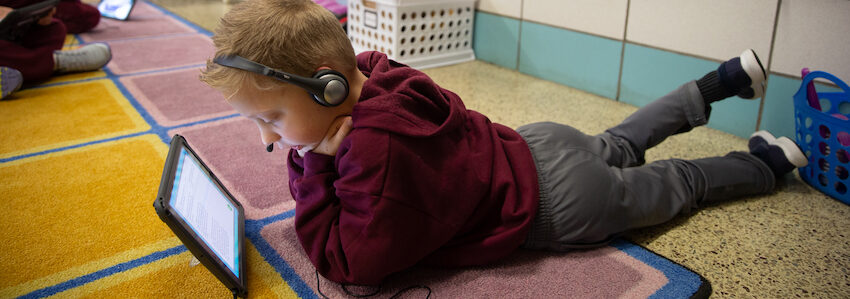
Have you ever read a book and felt like the author wrote it just for you? A book that was so profound that you felt changed by the experience? Now imagine you’d never read that book. Or couldn’t. Or that you read the book but didn’t understand it. How would you feel? That is the power of reading. It can change you for the better. It can immerse you in a different world. It can make you feel seen. But it can also completely strip away your confidence and make you feel powerless. There is more we can do to help young readers experience the best of what books have to offer them.
Being able to read is a skill everyone deserves to learn. But according to a report by the Barbara Bush Foundation for Family Literacy, about 54% of adults in the United States read below a sixth-grade level. That same report explains that adults with lower literacy rates tend to earn less, which can affect the quality of life for them and their families.
We need to do better at teaching kids to read, so we can raise literacy rates and increase the variety of professional opportunities available to our students when they graduate. Two ways we can help students are empowerment and building knowledge.
3 ways to empower young readers
Empowerment is motivating. Kids who are empowered are more likely to enjoy reading and to become lifelong readers. Here are three ideas for you to consider:
1. Follow reading science
The science of reading has outlined what matters in teaching students to read and comprehend. High-quality instruction in phonemic awareness, phonics and word recognition, fluency, vocabulary and oral language comprehension, and text comprehension is crucial for helping all students learn to read.
It is also important to remember that reading isn’t a bunch of disparate skills that kids learn in isolation. Yes, students need to learn how to decode, but equally important is their volume of reading, the access they have to complex texts, and the opportunities they are given to build knowledge (more on all of that later).
2. Offer windows, mirrors, and sliding glass doors
Rudine Sims Bishop is widely credited with introducing the concept of windows, mirrors, and sliding glass doors.
Books that are windows show a reader a world that is different from their own. Sometimes those books can also be sliding glass doors, where the reader can imagine themselves as a part of the world they are reading about. Books that are mirrors show readers a world that reflects their own lived experiences back at them.
Why is all of this important? Seeing a world larger than our own can help us develop both emotional intelligence and empathy. Students who see themselves in what they read feel valued and that their experiences matter. This, in turn, can lead to them feeling empowered and, hopefully, motivated to read more.
Think about your class and the materials you select for them. How do you expose them to worlds different from their own? What are the things you look for that acknowledge your students’ lived experiences?
3. Elevate multilingual learners
As my colleague Teresa Krastel wrote, teachers must capitalize on multilingual learners’ superpowers, including funds of knowledge from their homes and home cultures. Even if a student is developing literacy in English, we must remember to honor and use the language knowledge these students already have. This can help them learn to read in English. It can also help them make sense of what they read because they have more of the context they need to understand.
Just as with mirrors, students who feel as though their home language and funds of knowledge are valued will almost certainly feel more empowered and motivated as young readers. Are there ways you could learn more about the multilingual learners in your classroom?
How to build knowledge
We all bring background knowledge to what we read. It serves as context that helps us understand texts. Read these two sentences, and I’ll show you how:
- Superconductivity is the flow of an electrical current through a material without transferring thermal energy out of the material, and it typically requires extremely low temperatures.
- The Harlem Renaissance was an important period of cultural and intellectual expression in Black history between World War I and the mid-1930s.
Was one of the sentences easier for you to understand? If you have knowledge of engineering or science, then the first sentence was probably easier. If you have knowledge of Black history, then the second sentence probably was. Or, if you are super lucky, you know a lot about superconductivity and you know a lot about Black history, so you had an easy time understanding both sentences.
If one or both of the sentences felt overwhelming to you, it was likely because you don’t have enough background knowledge to help you as you read about those topics. The sentences don’t provide enough context to help you understand. This is just an example of how the more we know about a topic, the easier it is to understand what we read. And the more we read on a topic that’s already familiar to us, the more new knowledge we can gain. Knowledge begets more knowledge for adults and young readers alike.
As a teacher, you can leverage the knowledge your students already have and build upon it. This can help your young readers make connections and comprehend what they read. But it’s also important to understand that not all your students will have the same amount of knowledge on any one topic. That’s where building knowledge comes in. Here are four things to try:
1. Give students plenty of time for independent reading
Independent reading directly contributes to the volume of reading students do. This is so important for building stamina, which helps improve reading skills overall, and it also builds knowledge.
Scaffolded silent reading, or ScSR, is independent reading with support from you, the teacher. It might sound counterintuitive at first. How can you help your young readers build knowledge if they are reading independently? By helping them choose appropriate texts!
When you help students choose appropriate texts and provide scaffolding, you help them read grade-level texts at a variety of complexity levels. (Remember: It’s always important to provide students access to grade-level texts.) I encourage you to also have regular check-ins with students to monitor comprehension and hold them accountable for their reading time. One way you can do this is to use reading response journal prompts for younger students and dialectical journals for older students.
Another way to make good use of independent reading time is literature circles, where groups of students read and discuss the same book. Help your young readers choose the books and groups. Ensure students are assigned roles (a circle role sheet can help) and that discussions are guided and focused.
2. Read aloud
Building knowledge begins even before students can read independently. Teachers of younger students build knowledge all the time by reading aloud.
The same kinds of scaffolding you would provide to independent readers can be used with read-alouds, such as asking questions and having students respond in writing (or drawing, for younger kids).
3. Support reading in the disciplines and digital literacy
Reading complex texts with rich vocabulary builds knowledge. Complex texts are especially important for building knowledge in different disciplines, like science and social studies. They also help older readers develop the skills necessary to approach and gain knowledge from texts in different disciplines. This is referred to as disciplinary literacy.
Digital literacy is also essential for accessing and building knowledge in the disciplines. Reading should not just happen in print, and students need guidance for navigating the digital world that is literally at their fingertips. My colleague Laura Hansen shares some tips in “3 ways to improve students’ digital literacy skills.”
While both disciplinary and digital literacy are more relevant for older students, it’s never too early to begin introducing the concepts to younger readers.
4. Help students connect the dots
Activating background knowledge is an important start to building new knowledge. But it is not necessarily an intuitive skill. Students need to be taught how to connect what they already know to the new knowledge in the texts they read. Students need lots of practice doing this with all kinds of texts.
Build activities that facilitate asking your young readers what they already know about a topic an assigned text covers. Point out the ways the text helps them learn something new.
Don’t forget about multilingual learners, who benefit from knowledge-building just as much as native English speakers do. Comprehension is stronger when students can activate the knowledge they already have about a text, regardless of language. Encourage and facilitate translanguaging to help multilingual students make meaning.
A love of reading
Empowerment and building knowledge are essential for improving reading. But they are also crucial for building young readers’ confidence. Our job as educators is to give students the tools they need to become strong readers. This can lead to better outcomes once they reach adulthood.




